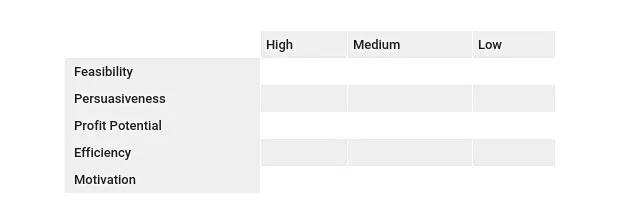If you’ve ever received an email from PayPal or some other “You’ve got money” notification, you know how it feels to get paid in addition to your paycheck. If you haven’t, here’s a hint: It feels good! The problem, of course, is that you’re busy—possibly too busy to develop a lucrative side hustle. You have a job and no shortage of other responsibilities, in addition to that elusive “social life” you’ve heard people talk about.
But the truth is that if you can carve out 20 to 30 minutes a day—in other words, part of your daily lunch break—to developing your side hustle, you will have something tangible to show for it in just five weeks. Here’s a quick overview of what it takes, based on the detailed plan I lay out in my new book, Side Hustle: From Idea to Income in 27 Days.
Weeks 1 And 2: Test And Choose The Best Idea
You probably didn’t learn Side Hustling 101 in college, or if you did, you just learned how to trade time for money. But that’s not what we’re trying to accomplish here—you need to create an asset that earns money for you.
Fortunately, this skill isn’t difficult to acquire at any age. You just need to be observant. By focusing on problems and frustrations you encounter in daily life, as well as taking a detailed inventory of your own knowledge and life experience, you’ll walk away with at least several good ideas. Spend your first week brainstorming, then, once you have multiple ideas, it’s time to identify the best ones. The key is to rank and compare different ideas based on criteria like feasibility, profit potential, and your own motivations.
How, exactly? Here’s a chart you can use for your analysis. Assign each of your ideas a value (high, medium, or low) based on the criteria on the left. If you’re not sure what value to assign, just estimate—it doesn’t need to be precise.

- Have imaginary coffee with your ideal customer. What do you talk about, and does she walk away convinced?
- Create your origins story. Does it seem plausible and compelling?
- Transform your idea into a hypothetical offer. What’s the actual product or service that you’ll offer to customers, and how much will it cost?
What if you do all this and still can’t choose which idea to run with? Then you just need to pick something. You’re making a decision for the next 27 days (or a similarly short period of time), not the rest of your life. It’s better to just pick something than to remain stuck.
Whatever you do, you need to start thinking about your idea in concrete terms as soon as possible. As consumers, we don’t buy ideas; we buy products and services. So what’s your product or service? How much will it cost? How will you get paid? Only by going from general idea to specific offer will you be able to make money.
Weeks 3 And 4: Develop And Launch Your Idea
You’ve settled on your idea, you’ve transformed it into an offer, and you know who your ideal customer is. Now it’s time to help that person understand why they can’t live without your offer, without getting bogged down in trivial details. An offer includes a promise, a pitch, and a price. It also helps to be able to explain your offer in one sentence: Why will this product or service matter? Don’t get ahead of yourself. You need that sentence before you can develop whatever you need to put your idea out into the world. Need a website? A shopping cart? A scheduling system? These logistical issues come next.
Your goal in the beginning of this third week is to understand each deliverable, resource, and tool you need—and every action you need to take to launch your offer soon. The goal for the rest of the week is to create those deliverables and take those actions.
So break it down into stages: Maybe on Monday you do some market research, looking at competitors and talking to target customers in order to decide how best to price your offer. By Wednesday you should be able to nail down a “shopping list” of the tools you’ll need (a website, a Twitter account, etc.) to bring your product to market. And by Friday, you should be able to define your first workflow, understanding each step from how a customer will make a purchase to how you’ll deliver what they’ve paid for.
By week four, you should be all set to take your offer into the world. The time is now—don’t wait! Successful side hustlers publish their offers before they feel completely ready. “I wanted to wait two more weeks,” one app developer told me, “but a deadline was coming up and I had to submit the app or abandon the idea.” He crossed his fingers and submitted the app. A month later, he’d made $2,700 from it—and it later went on to become his full-time income. You need to follow this guy’s model. Your offer will never be perfect. Not only that, but you also won’t gain the critical information you need to make it better until it’s out. Done is better than perfect.
Week 5: Regroup And Refine
Your side hustle is out in the world! Congratulations! Chances are that by the time week five rolls around, you’re expecting either tremendous success or colossal failure. But much of the time, there’s a third scenario: mixed results. You wanted to get three clients and you got one. You hoped to make $5,000, but you made $2,000.
So your main task the week after launch is simply to decide whether to keep investing time in this project or head back to week two and try a different one instead. Knowing when to quit and when to keep going is key to making any side hustle successful. But even if you decide to abandon the project and choose something different, the experience you’ve gained will help you be more successful with the next one.
Assuming you want to move forward with this idea, learning to make more money in an existing project is usually much easier than starting all over. You may want to add an additional version of your offer. If your offer is a product, you may want to create a service that shows people how to use it—or if it’s a service, you may want to create a product for people who just want to do it themselves. The options are unlimited, but it all starts with getting your offer out to the world.
Don’t quit your day job, but don’t wait to start a side hustle while you’re there. Whatever you do, don’t just set up a side gig that amounts to a part-time job. The key is to create an asset that will work for you. It takes less time than you probably think.
Chris Guillebeau is the author of Side Hustle: From Idea to Income in 27 Days. He hosts a popular daily podcast and is currently on an interactive 100-city tour to show people how to start earning money from their side hustles. Follow Chris on Twitter at @chrisguillebeau.
Recognize your brand’s excellence by applying to this year’s Brands That Matter Awards before the early-rate deadline, May 3.
